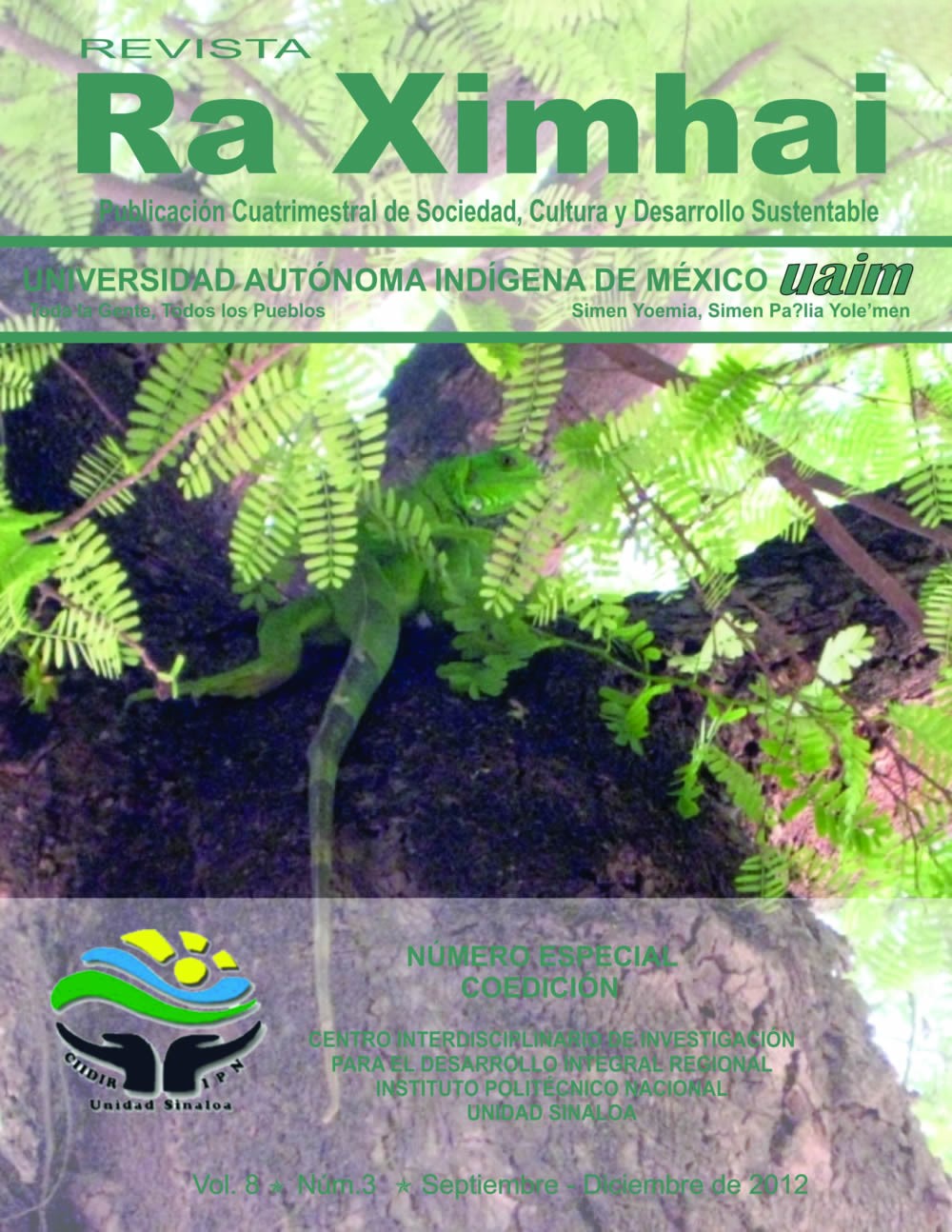Impact of nitrogen fertilization on water for human consumption in the municipality of Guasave Sinaloa, Mexico
DOI:
https://doi.org/10.35197/rx.08.03.e2.2012.02.aaKeywords:
nitrates, metahemoglobin, drinking water, agricultureAbstract
The practice of intensive agriculture in Guasave, Sinaloa, Mexico, promotes the application of high amounts of fertilizers in vegetable and grain crops; nitrates are the best known inorganic contaminants, those that most contaminate groundwater, and perhaps those that generate the greatest risk to health. The maximum concentration of nitrates in water for human consumption recommended by the Mexican Official Standard (NOM) is 10 mg L-1 of N-NO3; levels above this value should be a cause for concern due to their possible detrimental effect on human health, mainly by reducing oxygen transport in blood (methemoglobin). The main objective of this work is to analyze the levels of nitrates in water for human consumption in communities of the municipality of Guasave, Sinaloa. Two methods were used for the analysis: the Brucina method and the Merckoquant nitrate analysis method. The results show that nitrate concentrations in public drinking water networks and purification plants are above critical levels (10 mg L-1 of N-NO3) in different communities; the highest concentration (22.7 mg L-1 of N-NO3) was in Estación Bamoa, known for its horticultural activity where concentrations were found above NOM-127-SSA1-1994.
Downloads
References
Baccaro, K., Degorgue M., Lucca M., Picone L., Zamuner E. y Andreoli. 2006. Calidad de agua para consumo humano y riego en muestras del cinturón hortícola de mar de plata. Instituto Nacional de Tecnología Agropecuaria, Buenos Aires Argentina. RIA Revista de investigaciones agropecuarias. 35(3): 95-110.
Bauder, J. W.; Sinclair, K.N., and Lund, R.E. 1993. Physiographic and land use characteristics associated with nitrate-nitrogen in Montana groundwater. J. Environ. Qual. 22: 255-262.
Bill, P. E. 1998. Water conditioning and purification. pp. 42-45.
Cecil, L. 1996. Tex Book of medicine. 20th ed. Washington DC: Mc GrowHill Interamericana. 875-876. Cruz, H. M. 1994. Tratado de Pediatría. 7ª ed. España: Editorial Publicaciones Médicas Barcelona, España.
p.
Fernícola, N. A. 1989. Infantile methemoglobinemia caused by nitrates. Boletín de la Oficina Sanitaria Panamericana. 106(1): 32-40.
INIFAP, 2003. Guía para la asistencia técnica agrícola para el área de influencia del Campo Experimental Valle del Fuerte, Sinaloa. Agenda Técnica, Sexta Edición. Juan José Ríos, Guasave, Sinaloa, México. 280 p.
Keeney, D. R. 1982. Nitrogen management for maximum efficiency and minimum pollution. Farmed soils, fertilizer, agroecosystems. Agronomy. A series of monographs-Americans Society of Agronomy. (22):605-649.
Knobeloch, L., Salna B., Hogan A., Postle J. and Anderson H. 2000. Blue babies and nitrate-contaminated well water. Environmental Health Perspectives. 108(7): 675-678.
Larios, O. L. 2009. Metahemoglobinemia en niños: situación actual. Archivo Médico de Camagüey, Centro Provincial de Ciencias Médicas de Camagüey, Cuba. 13(3): 1-9
Leanza, L. N. y Parent Jorge R. 2005. Nitratos y Nitritos en agua subterránea–Aspectos Generales. 1ª edición, pp.7-8. Dirección Nacional del Derecho de Autor Expediente N° 419105.
Lucey, K. J. and Goolsby, E. 1993. Effect of climatic variations over 11 years on nitrate-nitrogen concentrations in the racoon river, Iowa. J. Environ. Qual. 22: 38-46.
Nolan, B. T. 1999. Nitrate behavior in ground waters of the southeastern USA, Reston. J. Environ. Qual.
: 1518-1527.
OMS, 1984. Guidelines for Drinking-Water Quality. Volume 2. Health criteria and other supporting information. Organización Mundial de la Salud Ginebra.
OMS, 1989. Health Guidelines for the use of wastewater in agriculture and aquaculture. Report of Scientific group meeting. Technical Report Series No. 778, Organización Mundial de la Salud, Ginebra.
Ramanathan, V., Cicerone, R. J., Singh, H. B. y Kiehl. 1985. Trace gas trends and their potential role in climate change. J. Geophys. Res. 90: 5547-5566.
Richards, R. P.; Baker, D. B.; Creameer, N. L.; Kramer, J. W.; Ewing, .E.; Merryfield, B. J. and L. K.Wallrabenstein. 1996. Well water quality, well vulnerability, and agricultural contamination in the midwestern United States. J. Environ. Qual. 25:384-402.
Sasson, A. 1993. La alimentación del hombre del mañana. UNESCO. Reverté S.A
Smith, J. U., Bradbury, N.J. and Adiscott, T.M. 1996. Sundial: A PC-based system for simulating nitrogen dynamics in arable land. Agron. J. 88: 38-43.
USEPA. 1986. Maximum contaminant levels subpart B of part 141, National interim primary drinking water regulations. In: U.S. Code of Federal Regulations. Title 40, Parts 100 to 149, Revised as 1 July 1986, pp. 524-528 and 567-568. USEPA, Washington, DC, USA.
Vitoria M I. 2001. ¿Hay qué hervir el agua potable durante diez minutos para preparar biberones?. (En línea). Disponible en: URL. http://db.doyma.es/cgiin/wdbcgi.exe/doyma/mrevista.fulltex? pident= 10021757.
Weil, R. R.; Weismiller, R. A. and Turner, R. S. 1990. Nitrate contamination of ground water under irrigated coastal plain soils. J. Environ. Qual. 19: 441-448.
Downloads
Published
How to Cite
Issue
Section
License
Copyright (c) 2012 Adolfo Dagoberto Armenta Bojórquez, Jesús Ricardo Camacho Báez, Cipriano García Gutiérrez, Manuel Mundo Ocampo, Julián Alberto Galaviz Lara, Carolina Cervantes Medina

This work is licensed under a Creative Commons Attribution-NonCommercial 4.0 International License.
Usted es libre de:
- Compartir — copiar y redistribuir el material en cualquier medio o formato
- Adaptar — remezclar, transformar y construir a partir del material
- La licenciante no puede revocar estas libertades en tanto usted siga los términos de la licencia
Bajo los siguientes términos:
- Atribución — Usted debe dar crédito de manera adecuada , brindar un enlace a la licencia, e indicar si se han realizado cambios . Puede hacerlo en cualquier forma razonable, pero no de forma tal que sugiera que usted o su uso tienen el apoyo de la licenciante.
- NoComercial — Usted no puede hacer uso del material con propósitos comerciales .
- No hay restricciones adicionales — No puede aplicar términos legales ni medidas tecnológicas que restrinjan legalmente a otras a hacer cualquier uso permitido por la licencia.








